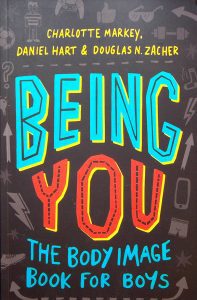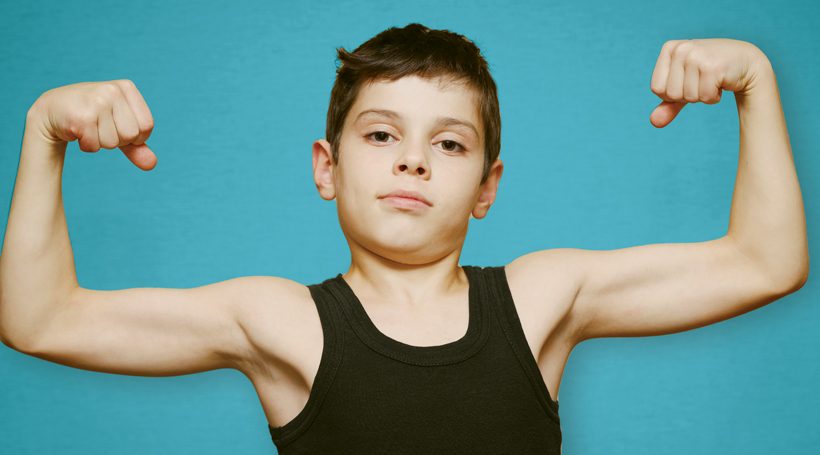
Body image isn’t a taboo subject anymore. On social media, the news, ad campaigns – people are championing self-love and body acceptance, specifically for women and young girls. But boys? The world is notably quieter on that.
Charlotte Markey, a Rutgers University-Camden psychology professor, thinks it’s time to start talking about it. Because, she says, boys go through just as many body image issues as girls – just in a different way. For her newest book, “The Body Image Book for Boys,” (a followup to her 2020 book, “The Body Image Book for Girls”) she and her research team interviewed dozens of boys and men about how they feel about their bodies. And she was surprised by what they found.
Q: What are some warning signs that boys might be developing a negative body image?
It’s interesting because it’s not at all what you would expect. With girls, it’s when you see her restricting what she’s eating, exercising a lot, agonizing over how her clothes fit. But with boys, a lot of the warning signs may, on the surface, seem healthy. They’ll focus on cutting out carbs or sweets. They might start going to the gym a lot. In moderate doses, that’s a great thing. But when it becomes all-consuming, that’s concerning.
Q: Can this lead to behaviors like eating disorders?
Absolutely. When an eating disorder sets in, it can become chronic – it’s right behind opioid addiction in terms of fatality rate. Restrictive eating, specific diets meant to “bulk up” and excessive exercise can all be signs.
Q: Why do you think we don’t talk about male body image?
What I’ve seen in my life and my research is that, often, men don’t have the language to talk about it. In interviews, I’d ask if they were dissatisfied with their bodies or use the word “body image,” and they would say “Oh, no. I’m fine.” Then I’d ask them to tell me about their eating habits, and they’d tell me about all the protein they were consuming and how often they worked out, and all of these things that revealed they were very concerned with their bodies. There’s often a disconnect between what men are feeling and how they’re able to identify and vocalize it.
Q: At what age should parents start talking to their sons?
My motto, for boys and girls, is early and often. There was a study a few years ago that asked 6-year-old boys about muscularity, and around 50% – at 6 years old – said they would look better if they had more muscles. Of course, that’s ridiculous because no one has muscles at that age. But it shows that this starts young, long before puberty.
Q: How can parents start the conversation?
It depends on the age. With preschool kids, we can start talking about issues of body diversity – appreciating that people come in all different shapes and sizes. We can talk about treating everyone the same, no matter their shape, size, skin color or gender. As they get older, you can start asking more specific questions about how they feel. You can come right out and ask, or if your kid doesn’t respond well to that, you can ask about their friends.
You can say, “I heard recently that a lot of boys want to be more muscular. I didn’t realize that was such a problem. Do you feel that way?” Or you ask if their friends are talking about things like that. If they aren’t talking about themselves at first, it may be easier for them to open up.
Q: What outside influences can impact a boy’s body image?
Social media, Hollywood, magazines – almost everything can send a message. When we’re young, we don’t think to question if there is something wrong with us physically. But then we get messaging from our family and the broader culture around us, and we start to see all the things we “need” to fix. The biggest culprit is advertising. We’re getting messages about all these products we need in order to look like the people we see on our screens, and we learn that we aren’t ok as we are.
Q: How can adults be more careful about that?
We can’t completely shield kids from the culture around them, but we can teach media literacy. We can show kids that what you see in the media is not realistic, that some claims are made specifically because they want to sell you something, or that the celebrities you see look like they do because it’s their entire job to look like that. It’s not always easy messaging, especially when you have a teenager.
Q: Did you find anything in your research that surprised you?
When I interviewed girls, some specific examples completely resonated with me. But I wasn’t prepared for the consistency in the boys’ stories as well. So many of them had that same degree of insecurity. It’s boys not wanting to take their shirts off at the pool because their friends would tease them, and they’d just laugh along even though they were really upset. As a person and as a parent, it really tugged at my heart.
Q: How does masculinity come into play in terms of boys’ experiences?
It’s interesting and important to consider that we often tell boys how important it is to be strong and stoic. It’s in the language we use from a young age – walk it off, man up, don’t be a wimp. Then we’re surprised when they grow into adolescents that are obsessed with going to the gym. This is the direction we’ve pointed them toward for years, and it’s a cycle we can stop.














